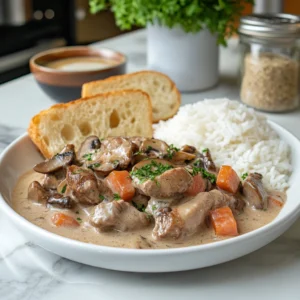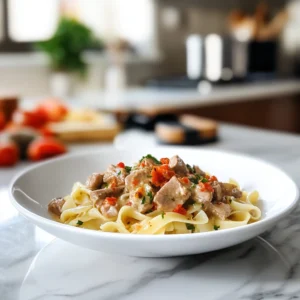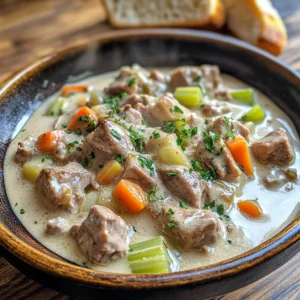Discover the art of preparing a delicious, non-alcoholic veal blanquette that honors traditional French cuisine while catering to modern dietary preferences. This comprehensive guide will walk you through the history, ingredients, step-by-step instructions, serving ideas, variations, and FAQs to ensure your dish is both authentic and accessible.
Did you know? For those looking to expand their culinary repertoire, consider exploring our vegetable egg roll recipe for another exciting twist in your kitchen!
Introduction
Veal blanquette is a classic French dish celebrated for its delicate flavors and tender meat. Traditionally prepared with white wine, the modern twist of eliminating alcohol opens the recipe to those who prefer a non-alcoholic lifestyle without compromising on taste.
- What to Expect:
- Insightful background on the dish
- Detailed ingredient breakdown with suitable substitutes
- A foolproof, step-by-step cooking guide
- Tips for presentation and flavor enhancement
- FAQs addressing common queries about the recipe
For additional inspiration, check out our leftover rotisserie chicken recipes if you’re looking for creative ways to repurpose your ingredients!
Historical Background
The Origins of Veal Blanquette
Veal blanquette is rooted in French culinary tradition. Originally prepared with a mix of tender veal, aromatic vegetables, and a velvety sauce enriched by white wine, it quickly became a staple in French households.
- Key Points:
- Traditional Recipe: Relies on wine to develop depth and aroma.
- Cultural Significance: Represents refined cooking and elegant dining.
- Modern Adaptations: Embraces substitutions that retain flavor without alcohol.
Why Go Non-Alcoholic?
- Health Considerations:
- Reducing alcohol intake for dietary or health reasons.
- Culinary Flexibility:
- Opens up the recipe for those who avoid alcohol due to personal or cultural preferences.
- Flavor Innovation:
- Encourages creative use of alternative liquids like broth or diluted fruit juices.
To further explore innovative cooking ideas, visit our tropical smoothie recipe for refreshing beverage options to complement your meal.
Key Ingredients & Non-Alcoholic Alternatives

Creating a sumptuous non-alcoholic veal blanquette starts with understanding each ingredient’s role and the best substitutes for alcohol.
Essential Ingredients
- Veal:
- Tender cuts such as shoulder or breast for optimal texture.
- Vegetables:
- Carrots, onions, and celery add depth and natural sweetness.
- Herbs & Spices:
- Bouquet garni (a bundle of thyme, bay leaves, and parsley) and peppercorns.
- Fats:
- Butter and olive oil to enhance richness.
Non-Alcoholic Liquid Alternatives
When eliminating wine, it is crucial to choose a substitute that will mirror its subtle acidity and aromatic properties.
- Broth Options:
- Chicken or Vegetable Broth: Provides a savory base without overpowering the dish.
- Diluted Grape Juice or Apple Cider Vinegar (mixed with water): Adds a slight tang, simulating wine’s acidic component.
- Benefits of Alternatives:
- Healthier Profile: Reduced alcohol content and lower calories.
- Enhanced Versatility: Opens up possibilities for other dishes, similar to our peanut butter brownie recipe, which experiments with flavor without alcohol.
Nutritional and Flavor Considerations
- Nutrition:
- The use of broth instead of wine can lower the overall calorie count while adding beneficial nutrients.
- Flavor Impact:
- Balancing the substitute with a mix of fresh herbs and a splash of lemon juice can create a robust flavor profile that complements the delicate taste of veal.
Step-by-Step Recipe Guide
Preparation and Mise en Place
Begin by ensuring all your ingredients are prepped and ready. This crucial step, known as mise en place, sets the foundation for a smooth cooking process.
- Steps:
- Trim and Cut the Veal:
- Remove excess fat and cut into uniform pieces.
- Prepare Vegetables:
- Dice carrots, onions, and celery.
- Gather Herbs and Spices:
- Bundle your bouquet garni and measure out peppercorns.
- Alternative Liquid Ready:
- Prepare your non-alcoholic liquid substitute (broth or diluted grape juice).
- Trim and Cut the Veal:
Cooking Instructions
Follow these detailed steps to create a rich, flavorful non-alcoholic veal blanquette:
- Sautéing the Veal
-
Heat the Pot: In a large pot, heat a mixture of butter and olive oil.
-
Sear the Veal: Sear the veal pieces until they achieve a golden-brown crust on all sides.
-
Tip: Avoid overcrowding the pan to ensure proper browning.
-
- Developing the Flavor Base
-
Set Aside the Veal: Remove the seared veal and set it aside.
-
Sauté Vegetables: In the same pot, add diced onions, carrots, and celery.
-
Cooking the Vegetables: Sauté until the vegetables soften and begin to caramelize.
-
Sautéing Tips:
-
Use medium heat.
-
Stir frequently to prevent burning.
-
Add a pinch of salt to help vegetables release their natural sugars.
-
-
- Deglazing the Pot
-
Deglaze with Liquid: Pour in your non-alcoholic substitute (chicken broth or diluted grape juice) to deglaze, ensuring all browned bits are incorporated into the sauce.
-
Alternative Tip: For an extra burst of flavor, add a splash of lemon juice.
-
- Simmering and Cooking
-
Return the Veal: Return the veal to the pot.
-
Add Herbs and Spices: Add the bouquet garni and peppercorns.
-
Simmer: Cover and let simmer on low heat for about 1.5 to 2 hours.
-
Important: Stir occasionally and monitor the liquid level; add more broth if needed to keep the ingredients just submerged.
-
- Final Adjustments
-
Seasoning: Once the veal is tender, adjust seasoning with salt, pepper, and a touch of lemon zest if desired.
-
Remove Herbs: Remove the bouquet garni before serving.
-
Optional Thickening: For a thicker sauce, you can mix a little flour with butter (beurre manié) and stir it in, cooking for a few additional minutes.
For more insights on how to combine flavors effectively, explore our how to combine spices: a comprehensive guide.
Expert Tips & Tricks
Elevate your non-alcoholic veal blanquette with these professional tips:
- Enhancing Flavor:
- Use fresh herbs instead of dried for a more vibrant taste.
- Add a few dashes of lemon juice at the end to brighten the flavors.
- Cooking Techniques:
- Low and Slow: Cooking at a low temperature ensures the veal remains tender.
- Deglazing: Don’t skip the deglazing step, it’s essential for incorporating all the flavorful bits.
- Presentation Tips:
- Garnishing: Top the dish with freshly chopped parsley or microgreens.
- Plating: Serve in a shallow bowl to showcase the velvety sauce.
Additional related recipes that highlight similar cooking techniques include our homemade pancake recipe (small batch) for perfect breakfast ideas or our boneless buffalo wings recipe for a crowd-pleasing snack.
Serving Suggestions & Pairings

A beautifully presented dish deserves equally thoughtful side dishes and beverage pairings.
Plating and Garnishing
- Presentation Ideas:
- Serve the veal blanquette in a wide, shallow bowl.
- Garnish with fresh parsley and a drizzle of extra virgin olive oil.
- Include a wedge of lemon on the side to allow guests to add an extra citrus note if desired.
Complementary Side Dishes
Enhance your meal with these well-matched side dishes:
- Starchy Sides:
- Rice: Steamed white rice or wild rice blends.
- Potatoes: Creamy mashed potatoes or buttered baby potatoes.
- Vegetable Options:
- Steamed Vegetables: Broccoli, green beans, or a medley of seasonal vegetables.
- Salads: A light, refreshing salad with a citrus dressing.
- Bread:
- Serve with a warm baguette or crusty bread to soak up the sauce.
Beverage Pairings
- Non-Alcoholic Options:
- Sparkling Water with Lemon: A crisp, refreshing complement.
- Herbal Iced Tea: Choose a lightly flavored tea, such as mint or chamomile.
- Creative Pairing:
- For a unique twist, pair with a glass of non-alcoholic sparkling grape juice.
For more pairing ideas, you might enjoy our brazilian lemonade refreshing lime drink recipe to add a citrus zing to your meal.
Variations and Adaptations
Adapting the veal blanquette without alcohol to suit different tastes and dietary needs can result in a versatile, crowd-pleasing dish.
Dietary Adaptations
- Gluten-Free:
- Replace flour with a gluten-free alternative when thickening the sauce.
- Low-Sodium:
- Use low-sodium broth and reduce added salt.
- Low-Fat:
- Substitute part of the butter with olive oil for a lighter sauce.
Flavor Variations

- Spicy Kick:
- Add a pinch of red pepper flakes or a dash of smoked paprika.
- Herbaceous Twist:
- Experiment with alternative herbs such as tarragon or rosemary.
- Occasion-Based Tweaks:
- For a festive version, include seasonal vegetables like butternut squash or parsnips for extra depth.
Creative Presentation
- Modern Plating:
- Serve the dish in a contemporary style with deconstructed elements.
- Rustic Charm:
- Emphasize a traditional, home-cooked appeal with hearty, rustic sides.
Curious about other culinary experiments? Check out our onion potato casserole recipe for an innovative twist on a classic comfort dish.

Non-Alcoholic Veal Blanquette
Equipment
- Large Pot or Dutch Oven
- Wooden Spoon
- Cutting Board
- Knife
- Ladle
Ingredients
Veal
- veal shoulder or breast Trimmed and cut into uniform pieces
Vegetables
- carrots Diced
- onions Diced
- celery Diced
Herbs & Spices
- bouquet garni Thyme, bay leaves, and parsley
- peppercorns
Fats
- butter
- olive oil
Non-Alcoholic Liquid Alternatives
- chicken or vegetable broth Savory base
- diluted grape juice or apple cider vinegar For subtle acidity
- lemon juice Optional for extra brightness
Final Adjustments
- salt and pepper To taste
- lemon zest Optional for extra freshness
- flour mixed with butter (beurre manié) Optional for thickening the sauce
Instructions
- Trim excess fat from the veal and cut it into uniform pieces.
- Dice the carrots, onions, and celery.
- Bundle thyme, bay leaves, and parsley into a bouquet garni.
- Prepare the non-alcoholic substitute (broth or diluted grape juice).
- Heat butter and olive oil in a large pot over medium-high heat.
- Sear the veal pieces until golden brown on all sides. Avoid overcrowding.
- Remove the seared veal and set aside.
- In the same pot, sauté onions, carrots, and celery until softened and caramelized.
- Deglaze the pot by adding broth or diluted grape juice, scraping up any browned bits.
- Return the veal to the pot and add the bouquet garni and peppercorns.
- Cover and let simmer on low heat for 1.5 to 2 hours, stirring occasionally.
- Check tenderness; the veal should be fork-tender.
- Adjust seasoning with salt, pepper, and a touch of lemon zest if desired.
- Remove the bouquet garni before serving.
- For a thicker sauce, mix flour with butter (beurre manié) and stir in, cooking for a few more minutes.
Notes
Frequently Asked Questions
What is Veal Blanquette?
- Veal blanquette is a traditional French stew made with tender veal, vegetables, and a creamy sauce, typically enriched with white wine. In our version, we substitute the wine with non-alcoholic alternatives to achieve a similar depth of flavor.
How Can I Replace Wine in the Recipe?
- Substitutes Include:
- Chicken or vegetable broth
- Diluted grape juice or apple cider vinegar (mixed with water)
- A splash of lemon juice for brightness
Can I Achieve a Rich Flavor Without Alcohol?
- Absolutely:
- The key is to use quality ingredients and techniques like proper deglazing and long, slow simmering to build flavor.
- Consider enhancing the dish with extra herbs and a careful balance of acidity.
What Sides Work Best With Non-Alcoholic Veal Blanquette?
- Recommended Sides:
- Steamed rice or mashed potatoes
- A light green salad
- Crusty bread to absorb the sauce
How Do I Avoid a Watery Sauce?
- Tips:
- Ensure you brown the meat properly.
- Use a controlled simmer rather than a rapid boil.
- Adjust the thickness with a beurre manié if necessary.
For more kitchen hacks, learn how to sharpen a knife: a comprehensive guide for a smoother cooking experience.
Conclusion
Creating a delightful non-alcoholic veal blanquette is a journey that honors both tradition and innovation. By embracing non-alcoholic alternatives, you can maintain the rich, comforting flavors of this classic dish while adapting to modern tastes and dietary needs.
- Key Takeaways:
- Veal blanquette is a versatile dish that can easily be transformed into a non-alcoholic version.
- The thoughtful substitution of ingredients like broth and diluted juices preserves the integrity and depth of the original recipe.
- With proper technique and presentation, this dish becomes a centerpiece for any meal, suitable for both casual and formal dining.
For further culinary adventures, you may also enjoy exploring our ultimate pizza burger recipe or experiment with flavors in our red cabbage recipes.
For more in-depth culinary insights, visit Fine Dining Lovers for expert advice and global trends.
Embrace the creativity in your kitchen, and let this guide be your roadmap to a truly memorable meal. Whether you’re cooking for family, friends, or a special occasion, your non-alcoholic veal blanquette will undoubtedly shine as a testament to innovative yet respectful cooking.
Bon appétit!

